Land Use as a Motivation for Railway Trespassing: Experience from the Czech Republic
Abstract
:1. Introduction
1.1. Situation in the CzechRepublic
1.2. Circumstances Contributing to Illegal Crossing and Types of Risk Localities
1.3. Aim of the Study
- (a)
- in cases of a railway intersecting an existing settlement structure; and
- (b)
- in cases of a railway built apart from the historical settlement structure and then gradually surrounded by built-up areas with various use functions.
2. Materials and Methods
2.1. Selection of Risk Localities and Field Surveys
2.2. Analysis of the Development of Land Use
- 1836–1852: II. Austrian military mapping 1:28,800
- 1876–1880: III. Austrian military mapping 1:25,000
- 1953–1955: Czechoslovak military topographic maps 1:25,000 + archival orthophotomaps
- 1988–1991: Czechoslovak and Czech military topographic maps 1:25,000
- 2014–2015 (actual situation): current orthophotomap + basic topographic map 1:10,000
- -
- railway introduced into existing spatial structures; or
- -
- later urbanization of originally open landscape along an existing railway.
3. Results
3.1. Evaluation of the Historical Development of Land Use in Model Areas
3.1.1. Brno–Řečkovice
3.1.2. Hodonín
3.1.3. Karviná
3.1.4. Ostrava–Vítkovice and Ostrava–Kunčice
3.1.5. Třinec
3.2. Changes in Functional Land Use and Motivation for Crossing the Railway
4. Discussion
- (a)
- in cases of a railway intersecting an existing settlement structure; and
- (b)
- in cases of a railway built apart from the historical settlement structure and then gradually surrounded by built-up areas with various use functions.
5. Conclusions
Acknowledgments
Author Contributions
Conflicts of Interest
References
- Anonymous. Summary Report of the Traffic Accidents in the Czech Republic in 2015; Directorate of the Traffic Police of the Police Presidium of the Czech Republic: Praha, Czech Republic, 2016. [Google Scholar]
- Havarneanu, G.M.; Burkhardt, J.; Paran, F. A systematic review of the literature on safety measures to prevent railway suicides and trespassing accidents. Accid. Anal. Prev. 2015, 81, 30–50. [Google Scholar] [CrossRef] [PubMed]
- Havarneanu, G.M.; Bonneau, M.H.; Colliard, J. Lessons learned from the collaborative European project RESTRAIL: REduction of Suicides and Trespasses on RAILway property. Eur. Transp. Res. Rev. 2016, 8, 1–15. [Google Scholar] [CrossRef]
- Silla, A.; Vainiomäki, V. Feasibility Study on the Use of Spatial Analysis in the Prevention of Rail Train-Trespasser Collisions: Effective Recommendations for Level Crossing Safety with Theme Investigation. In Proceedings of the 14th Global Level Crossing Safety and Trespass Prevention Symposium, Helsinki, Finland, 12–16 June 2016. [Google Scholar]
- Silla, A.; Luoma, J. Trespassing on Finnish railways: Identification of problem sites and characteristics of trespassing behaviour. Eur. Transp. Res. Rev. 2008, 1, 47–53. [Google Scholar] [CrossRef]
- Silla, A.; Luoma, J. Opinions on railway trespassing of people living close to a railway line. Saf. Sci. 2012, 5, 62–67. [Google Scholar] [CrossRef]
- Burkhardt, J.M.; Radbo, H.; Silla, A.; Paran, F. A Model of Suicide and Trespassing Processes to Support the Analysis and Decision Related Top Reventing Railway Suicides and Trespassing Accidents at Railways. In Proceedings of the Transport Research Arena, Paris, France, 14–17 April 2014; Available online: https://www.researchgate.net/publication/259381506_A_model_of_suicide_and_trespassing_processes_to_support_the_analysis_and_decision_related_to_preventing_railway_suicides_and_trespassing_accidents_at_railways (accessed on 30 December 2017).
- Lobb, B.; Harre, N.; Suddendorf, T. An evaluation of suburban railway pedestrian crossing safety programme. Accid. Anal. Prev. 2001, 33, 157–165. [Google Scholar] [CrossRef]
- RSSB. Annual Safety Performance Report 2013/2014; Rail Safety and Standards Board: London, UK, 2014. [Google Scholar]
- Da Silva, M.P. Railroad Infrastructure Trespass Detection Performance Guidelines; Final Report No. DOT/FRA/ORD-11/01a; Federal Railroad Administration: Washington, DC, USA, 2011.
- Özdogan, M.; Cakar, S.; Ağalar, F.; Eryilmaz, M.; Aytaç, B.; Aydinuraz, K. The epidemiology of the railway related casualties. Turk. J. Trauma Emerg. Surg. 2006, 12, 235–241. [Google Scholar]
- Stefanova, T.; Burkhardt, J.M.; Wullems, C.H.; Freeman, J.; Rakotonirainy, A.; Delhomme, P. Direct Observations of Pedestrian Unsafe Crossing at Urban Australian Level Crossings. Urban Rail Transit 2015, 1, 112–130. [Google Scholar] [CrossRef]
- Freeman, J.; Rakotonirainy, A. Mistakes or deliberate violations? A study into the origins of rule breaking at pedestrian train crossings. Accid. Anal. Prev. 2015, 77, 45–50. [Google Scholar] [CrossRef] [PubMed]
- Skládaná, P.; Skládaný, P.; Tučka, P.; Bidovský, M. Trespassing railway property-typology of risk localities. Transp. Res. Procedia 2016, 14, 2091–2100. [Google Scholar] [CrossRef]
- Savage, I. Trespassing on the rail road. Railr. Econ. 2007, 2, 199–224. [Google Scholar] [CrossRef]
- Skaloš, J.; Weber, M.; Lipský, Z.; Trpáková, I.; Šantrůčková, M.; Uhlířová, L.; Kukla, P. Using old military survey maps and orthophotograph maps to analyse long-term land cover changes—Case study (Czech Republic). Appl. Geogr. 2011, 31, 426–438. [Google Scholar] [CrossRef]
- Skokanová, H.; Havlíček, M.; Borovec, R.; Demek, J.; Eremiášová, R.; Chrudina, Z.; Mackovčin, P.; Rysková, R.; Slavík, P.; Stránská, T.; et al. Development of land use and main land use change processes in the period 1836–2006: Case study in the Czech Republic. J. Maps 2012, 8, 88–96. [Google Scholar] [CrossRef]
- Havlíček, M.; Chrudina, Z. Long-term land use changes in relation to selected relief characteristics in Western Carpathians and Western Pannonian basin–case study from Hodonín District (Czech Republic). Carpath. J. Earth Environ. Sci. 2013, 8, 231–244. [Google Scholar]
- Havlíček, M.; Dostál, I. Land use dynamics in the Hodonín district in the context of historical development of transport network. Acta Pruhon. 2012, 102, 57–64. [Google Scholar]
- Colonna, P.; Berloco, N.; Circella, G. The Interaction between Land Use and Transport Planning: A Methodological Issue. Procedia Soc. Behav. Sci. 2012, 53, 84–95. [Google Scholar] [CrossRef]
- Cervero, R. Linking urban transport and land use in developing countries. J. Transp. Land Use 2013, 6, 7–24. [Google Scholar] [CrossRef]
- DeVos, J.; Witlox, F. Transportation policy as spatial planning tool; reducing urban sprawl by increasing travel costs and clustering infrastructure and public transportation. J. Transp. Geogr. 2013, 3, 117–125. [Google Scholar] [CrossRef]
- Keken, Z.; Kušta, T.; Langer, P.; Skaloš, J. Landscape structural changes between 1950 and 2012 and their role in wildlife–vehicle collisions in the Czech Republic. Land Use Policy 2016, 59, 543–556. [Google Scholar] [CrossRef]
- Havlíček, M. Influence of Transportation on Landscape Changes. In Proceedings of the III Czech-Slovak Conference “Transport, Health and Environment”, Litomyšl, Czech Republic, 4–5 November 2008; Adamec, V., Dostál, I., Eds.; Centrum dopravního výzkumu: Brno, Czech Republic, 2008; pp. 119–126. [Google Scholar]
- Kasraian, D.; Maat, K.; Stead, D.; van Wee, B. Long-term impacts of transport infrastructure networks on land-use change: An international review of empirical studies. Transp. Rev. 2016, 36, 772–792. [Google Scholar] [CrossRef]
- Alvarez, E.; Franch, X.; Marti-Henneberg, J. Evolution of the Territorial Coverage of the Railway Network and its Influence on Population Growth: The Case of England and Wales, 1871–1931. Hist. Methods 2013, 46, 175–191. [Google Scholar] [CrossRef]
- Noonan, D.S. Neighbours, Barriers and Urban Environments: Are Things “Different on the Other Side of Tracks”? Urban Stud. 2005, 42, 1817–1835. [Google Scholar] [CrossRef]
- Bartke, S.; Martinát, S.; Klusáček, P.; Pizzol, L.; Alexandrescu, F.; Frantál, B.; Critto, A.; Zabeo, A. Targeted selection of brownfields from portfolios for sustainable regeneration: User experiences from five cases testing the Timbre Brownfield Prioritization Tool. J. Environ. Manag. 2006, 1, 94–107. [Google Scholar] [CrossRef] [PubMed]
- Tintěra, J.; Ruus, A.; Tohvri, E.; Kotval, Z. Urban brownfields in Estonia: Scope, consequences and redevelopment barriers as perceived by local governments. Morav. Geogr. Rep. 2014, 22, 25–38. [Google Scholar]
- Krejčí, T.; Dostál, I.; Havlíček, M.; Martinát, S. Exploring the hidden potential of sugar beet industry brownfields (case study of the Czech Republic). Transp. Res. Part D Transp. Environ. 2016, 46, 284–297. [Google Scholar] [CrossRef]
- Kubeček, J. Special Electronic Map of Train-Person Crashes. Transport Research Centre [Centrum Dopravního Výzkumu]. 2015. Available online: http://www.cdv.cz/~kubecek/amelia/index.php (accessed on 30 December 2017).
- Hudec, Z. Atlas of Railways of the Czech Republic 2006–2007; Dopravní Vydavatelství Malkus: Prague, Czech Republic, 2006. [Google Scholar]
- Mackovčin, P. Land use categorization based on topographic maps. Acta Pruhon. 2009, 91, 5–13. [Google Scholar]
- Dostál, I.; Havlíček, M.; Huzlík, J. Evaluation of Transport Impact to the Landscape. In Proceedings of the IV Czech-Slovak Scientific Conference “Transport, Health and Environment”, Blansko, Czech Republic, 2–3 November 2010; Adamec, V., Jandová, V., Eds.; Tribun EU: Brno, Czech Republic, 2010; pp. 97–104. [Google Scholar]
- Havlíček, M.; Svoboda, J.; Dostál, I. Development of Sugar Industry in Hodonín district and its Effect on Land-use changes and Transport Infrastructure. Listy Cukrov. Řepařské 2013, 129, 312–316. [Google Scholar]
- Martinát, S.; Navrátil, J.; Dvořák, P.; Klusáček, P.; Kulla, M.; Kunc, J.; Havlíček, M. The expansion of coalmining in the depression areas—Away to development? Hum. Geogr. 2014, 8, 5–15. [Google Scholar] [CrossRef]
- Zapletalová, J. Development of railway traffic and the network of sidings in the Ostrava region. Morav. Geogr. Rep. 2006, 14, 60–68. [Google Scholar]
- Liga, J.; Petrovič, F.; Boltižiar, M. Land cover changes in Slovakia 1990–2006 related to the distance from industrial areas and economic development. Geogr. Čas. 2014, 66, 3–20. [Google Scholar]
- Súľovský, M.; Falťan, V. Analysis of land use changes and their relations to topographic factors: Case study of the municipality Lietavská Svinná-Babkov. Geogr. Čas. 2015, 67, 45–62. [Google Scholar]
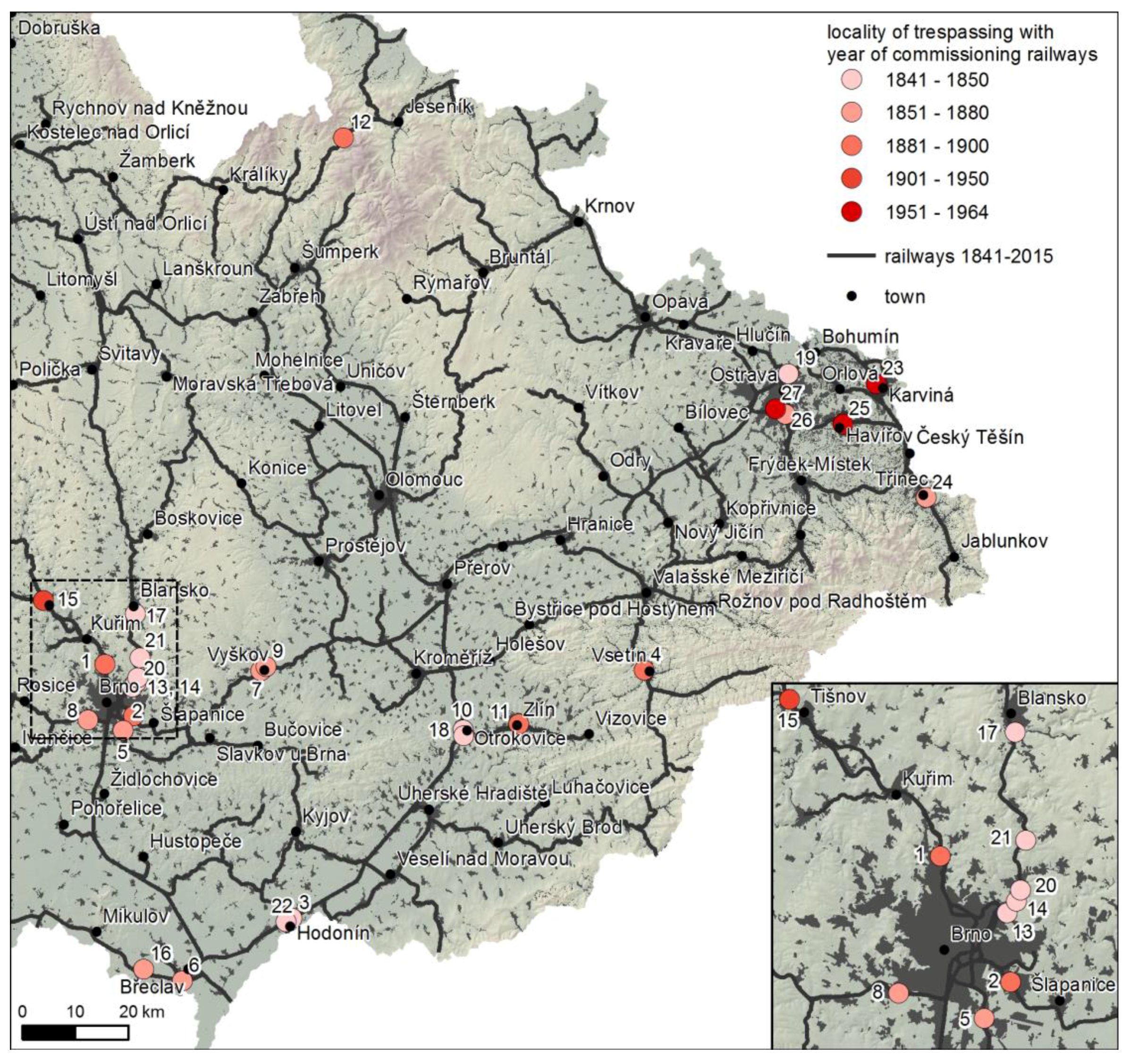
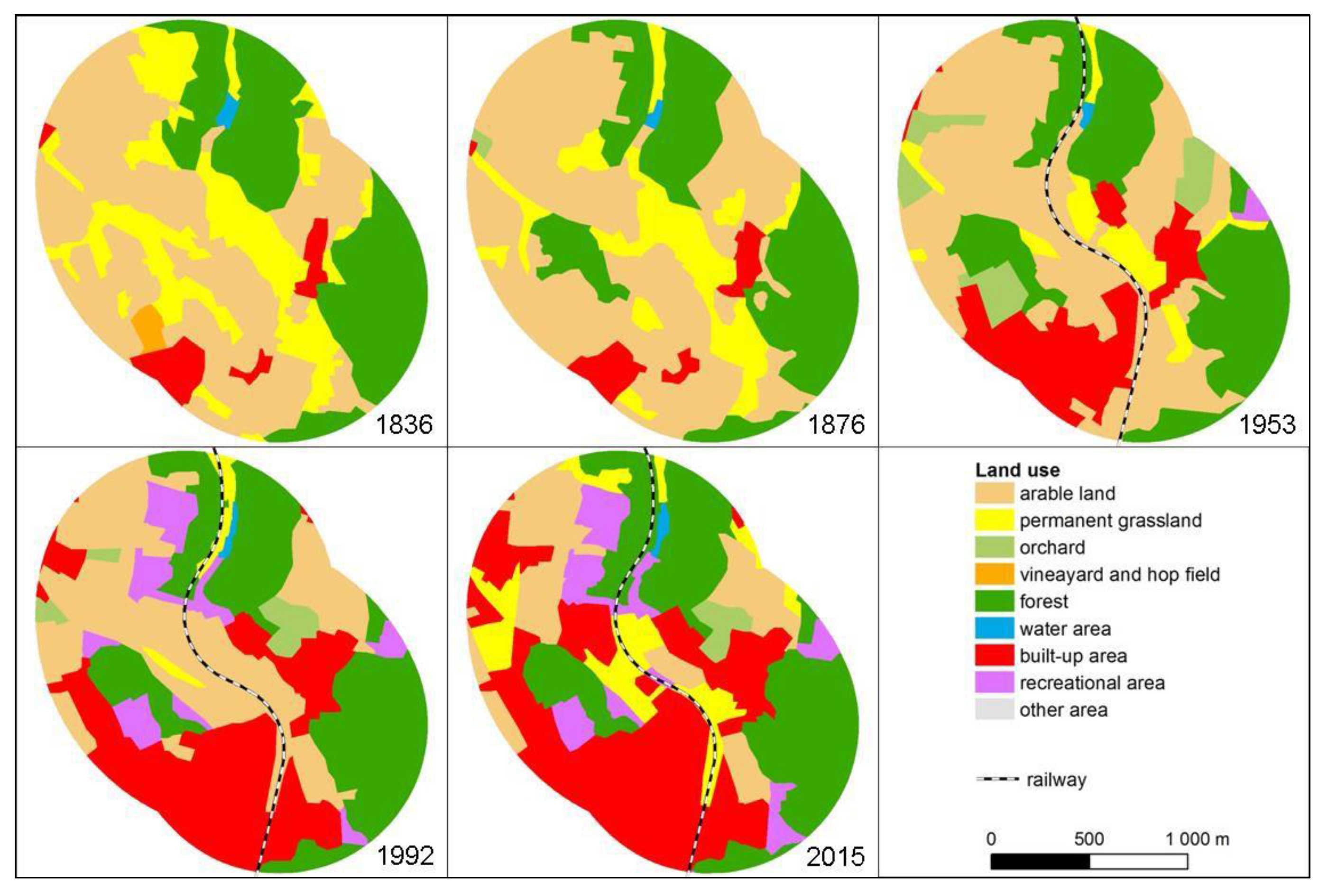
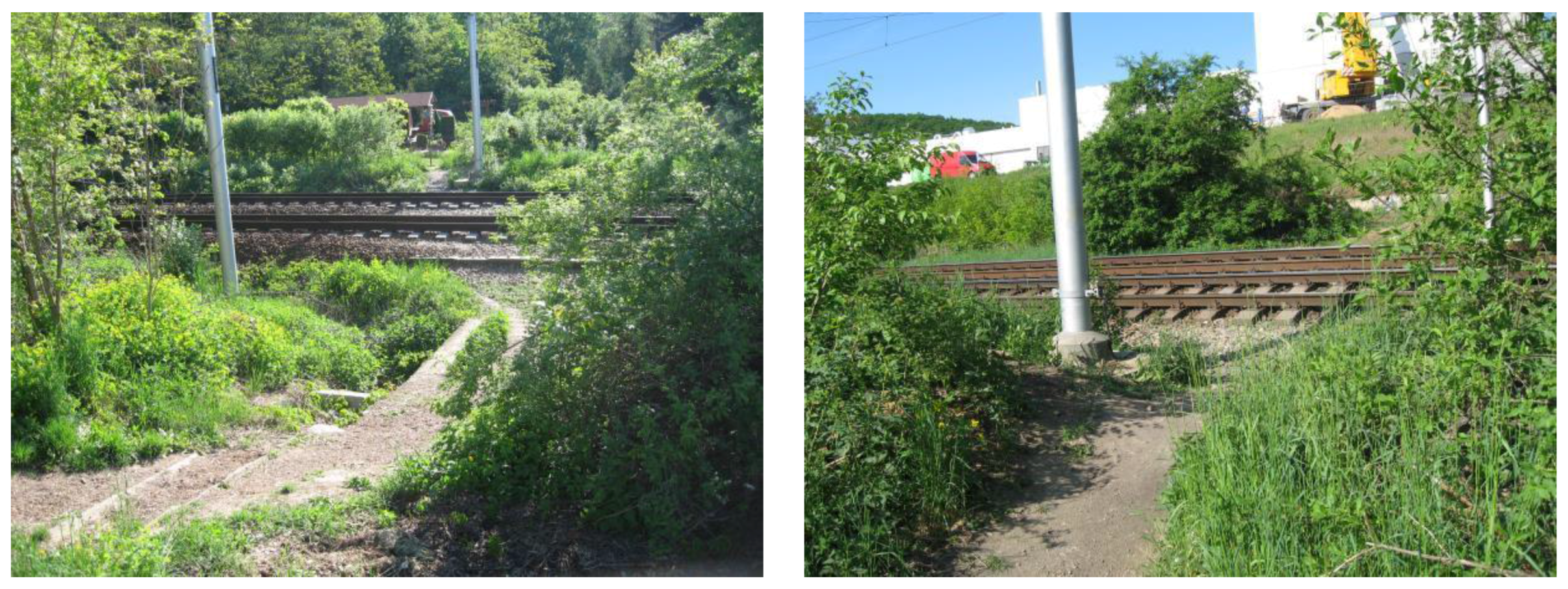
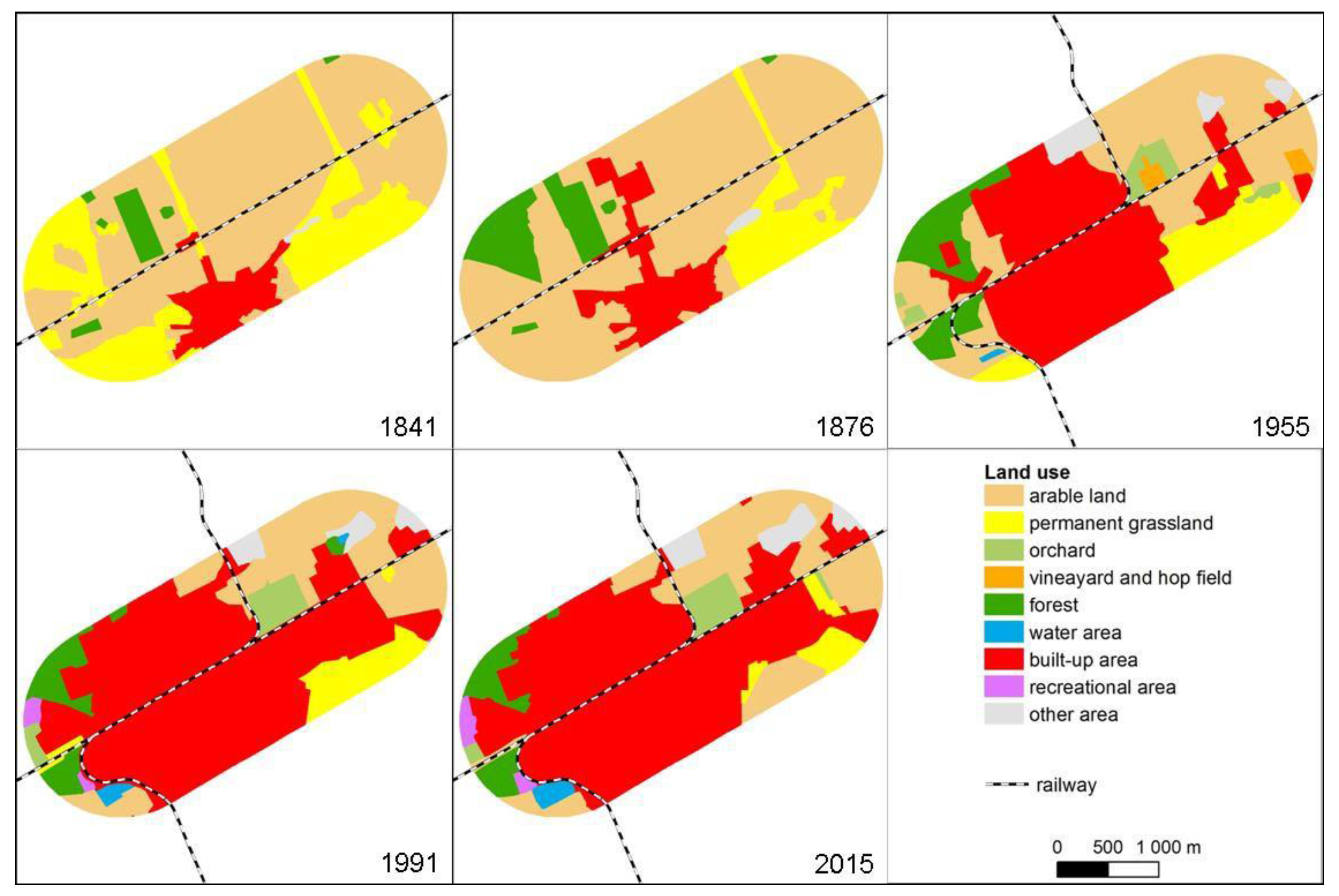
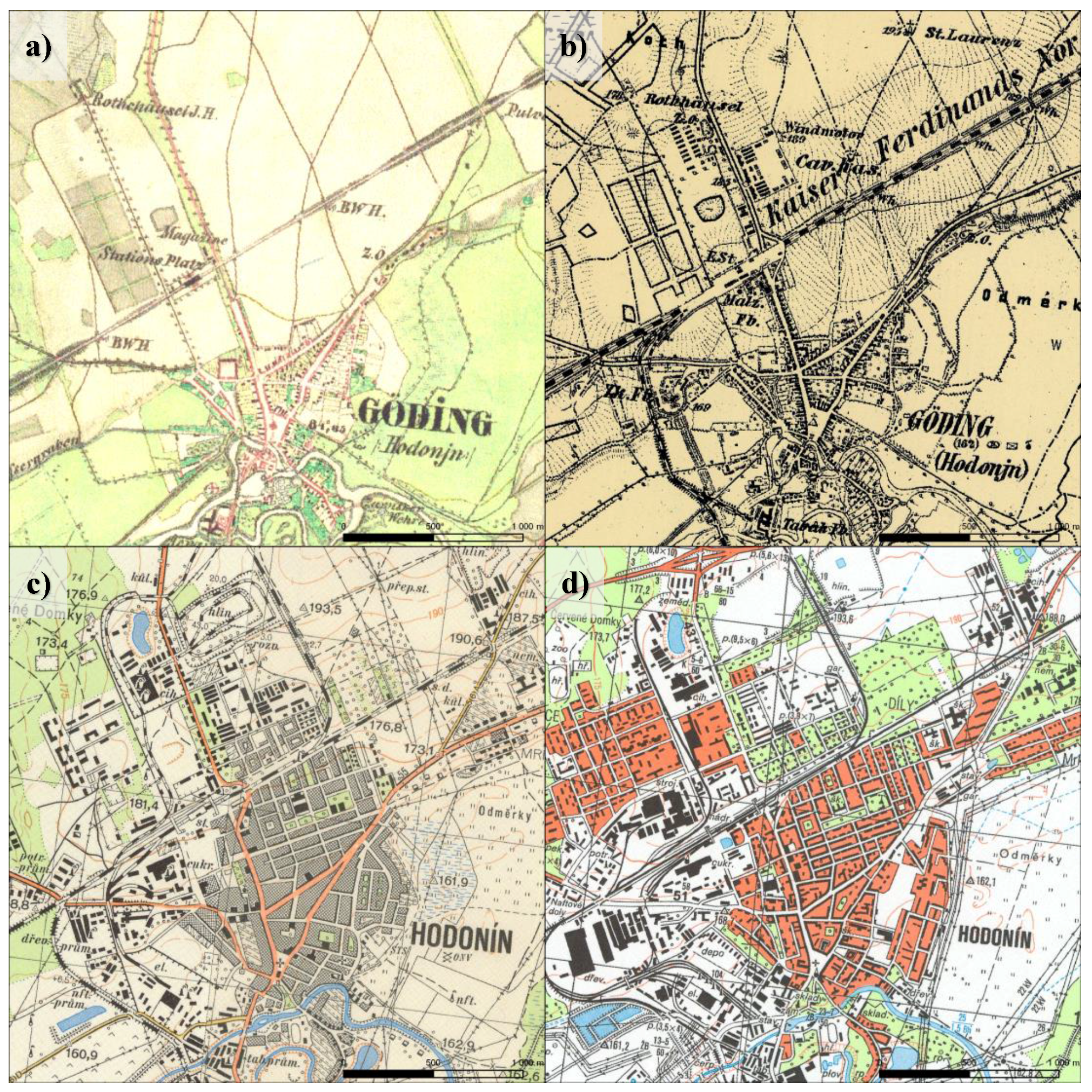
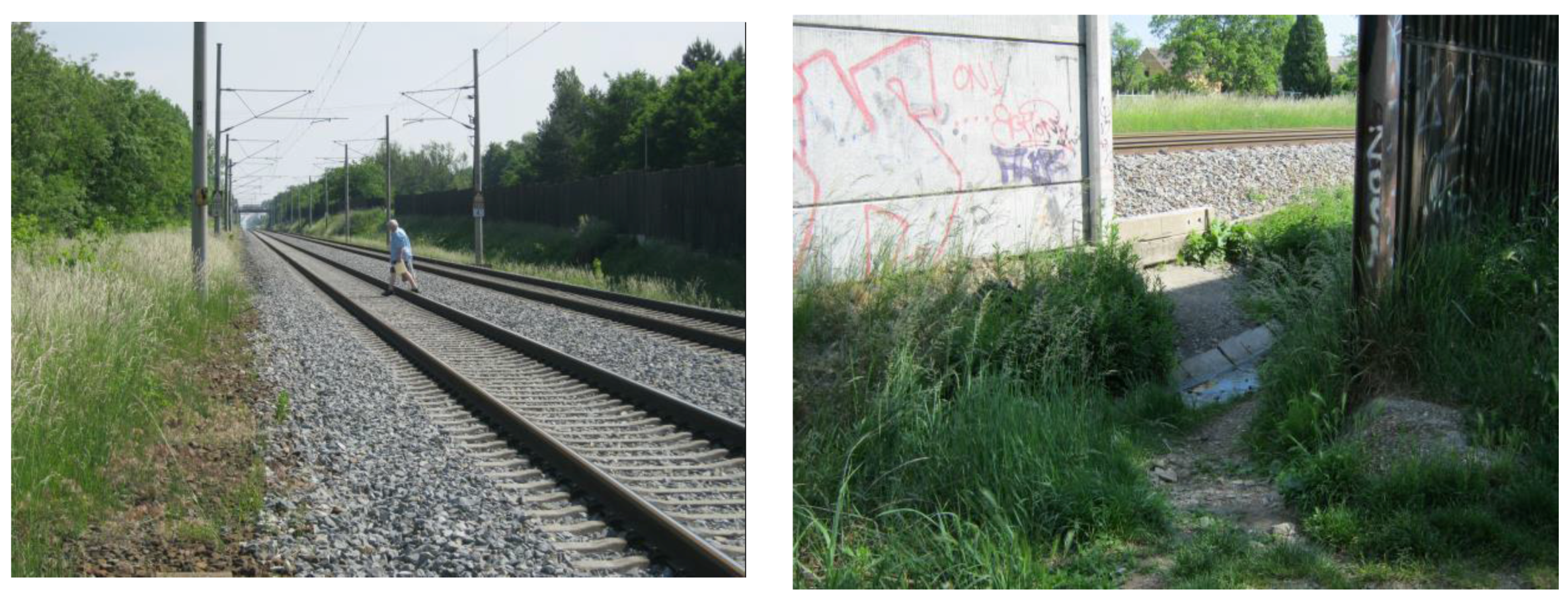
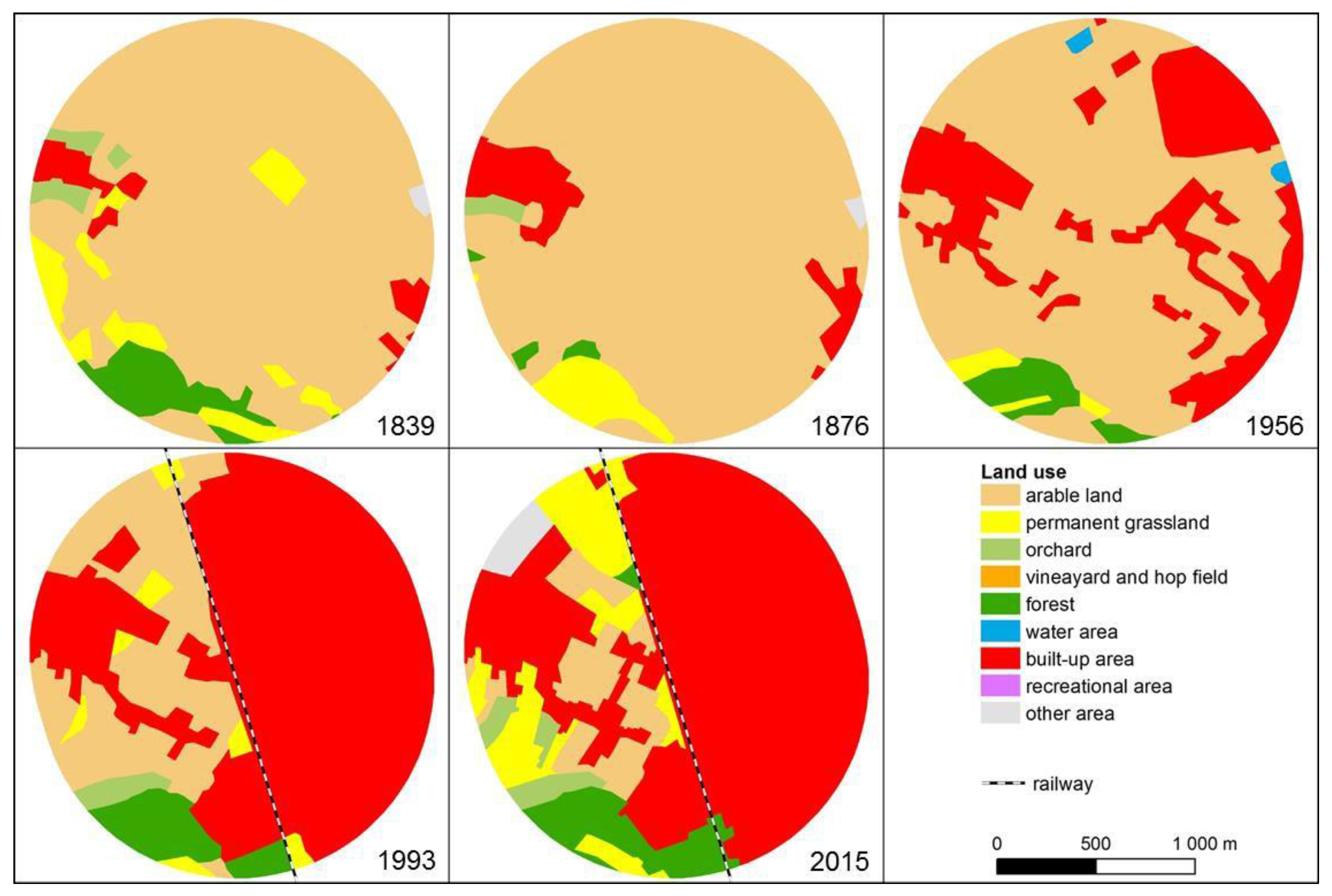
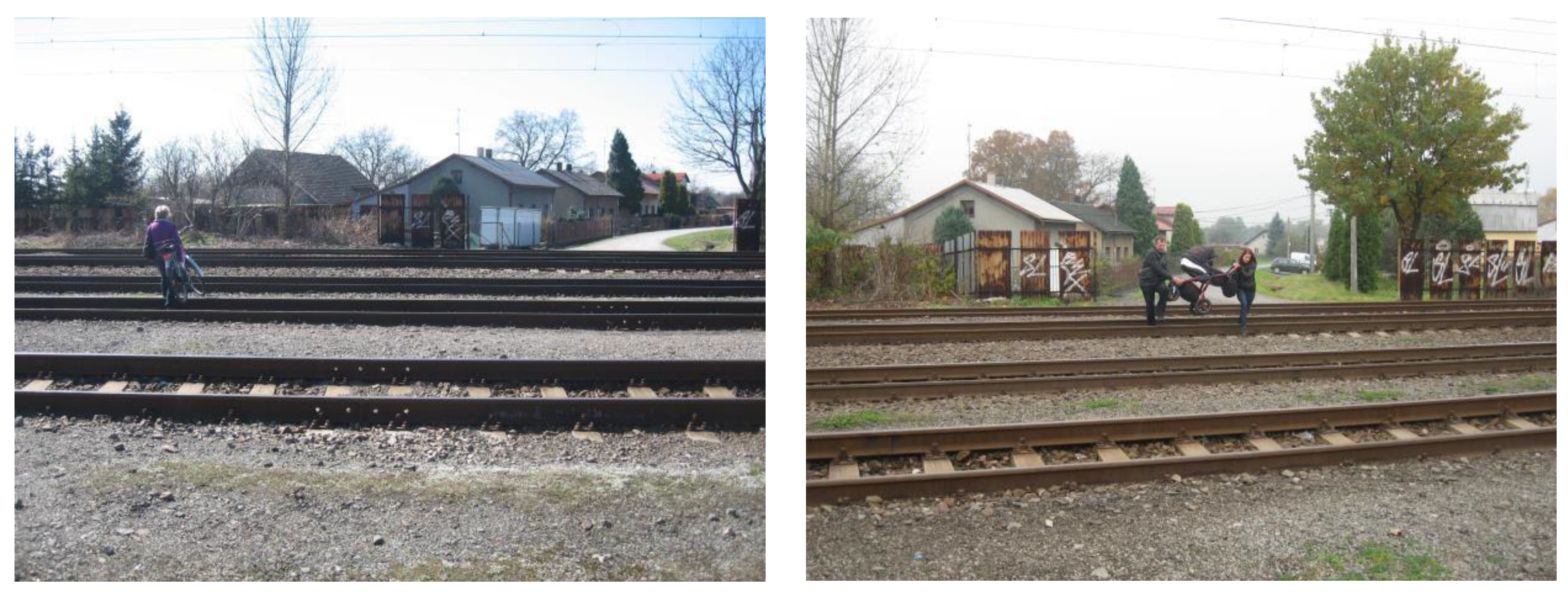
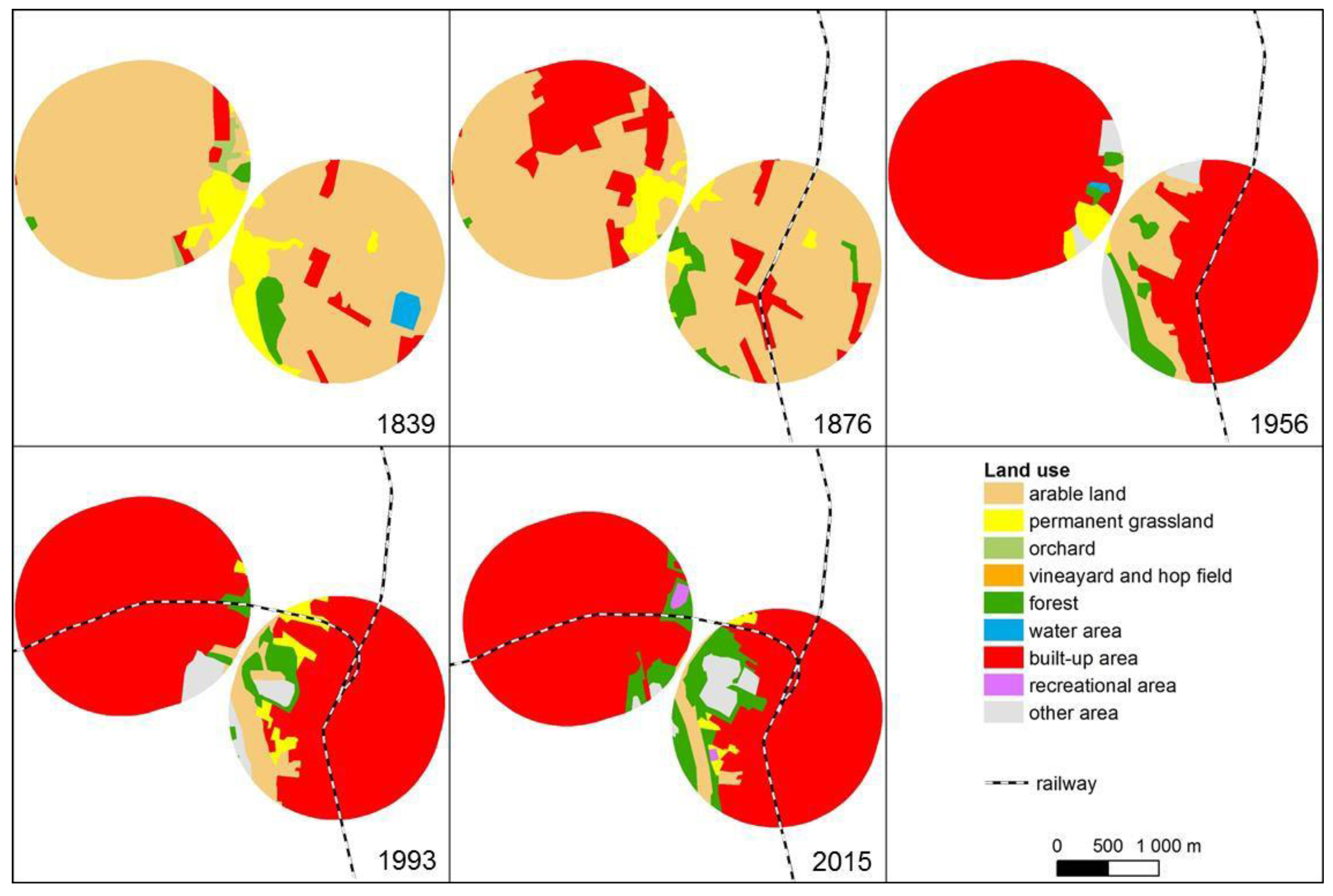
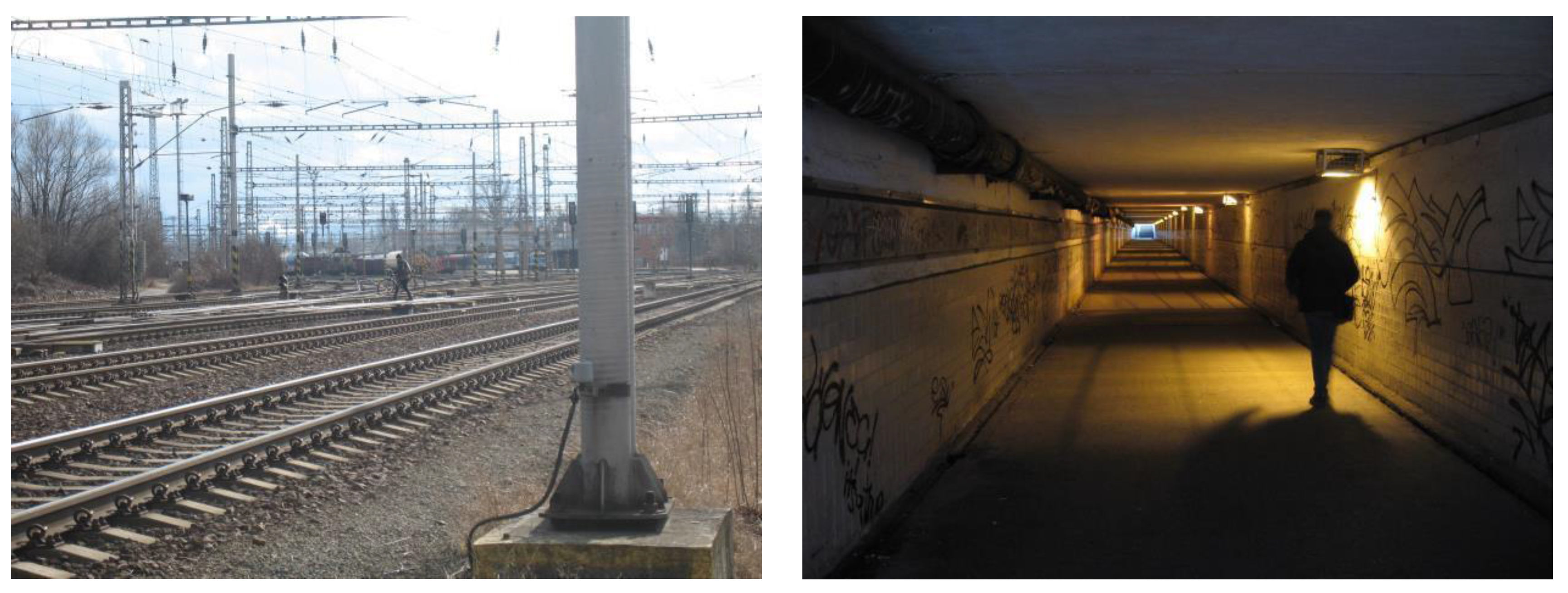
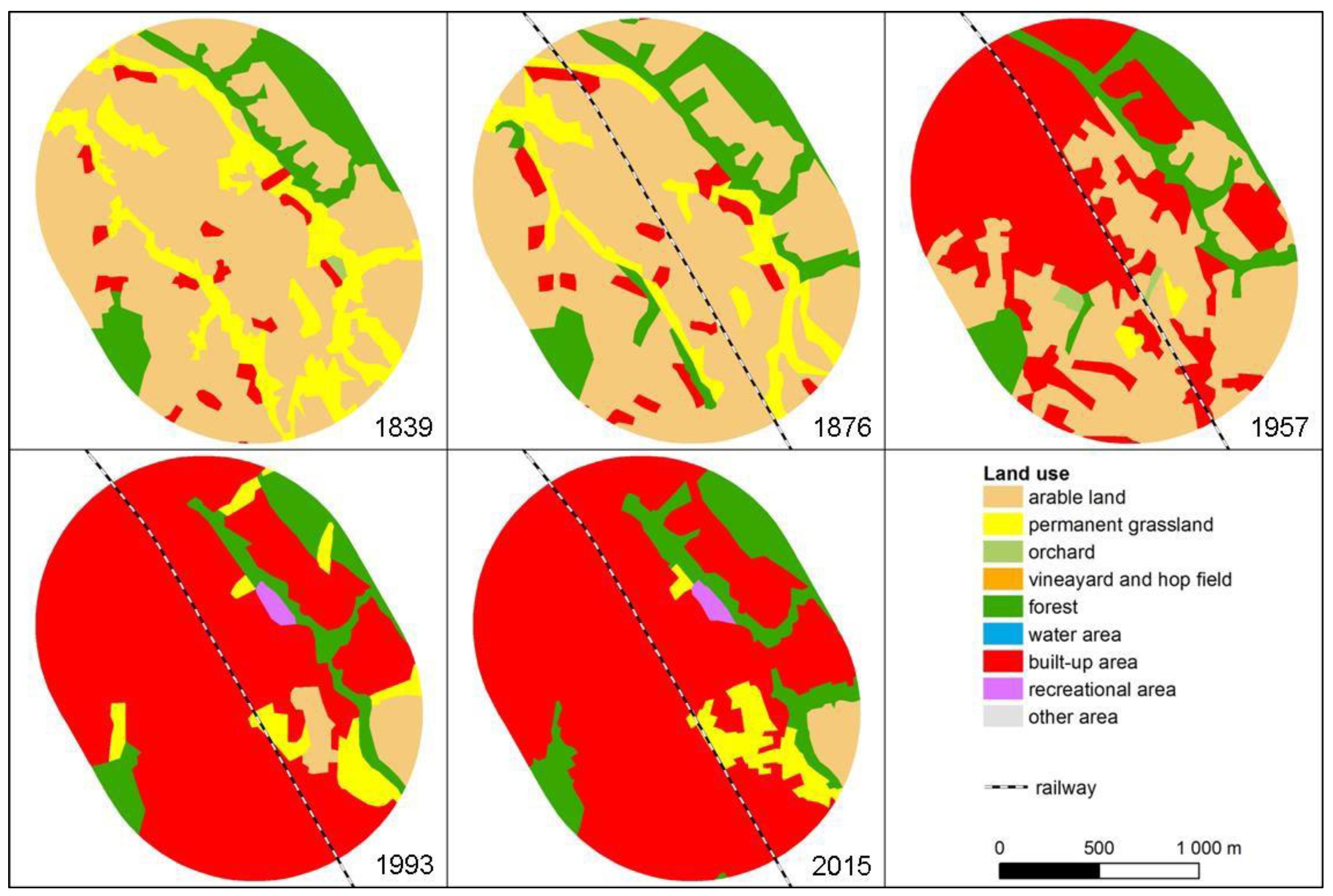
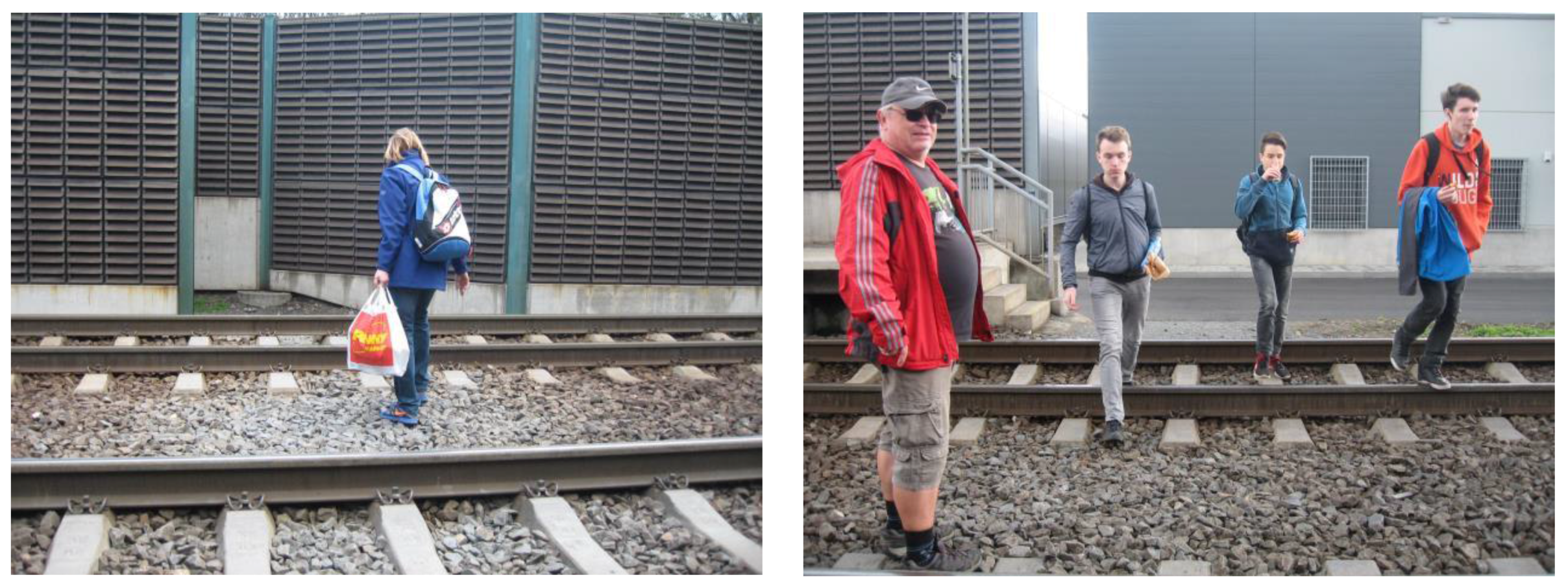
| Year | 1836–1852 | 1876–1880 | 1953–1955 | 1988–1991 | 2014–2015 | |||||
|---|---|---|---|---|---|---|---|---|---|---|
| Category | ha | % | ha | % | ha | % | ha | % | ha | % |
| Arable land | 6123 | 56.5 | 6564 | 60.6 | 4392 | 40.5 | 2032 | 18.7 | 1620 | 14.9 |
| Permanent grassland | 2191 | 20.2 | 1316 | 12.1 | 647 | 6.0 | 556 | 5.1 | 618 | 5.7 |
| Garden and orchard | 33 | 0.3 | 15 | 0.1 | 299 | 2.8 | 320 | 3.0 | 291 | 2.7 |
| Vineyard and hop field | 33 | 0.3 | 26 | 0.2 | 49 | 0.4 | 114 | 1.1 | 85 | 0.8 |
| Forest | 1764 | 16.3 | 1883 | 17.4 | 1934 | 17.8 | 2037 | 18.8 | 2106 | 19.4 |
| Water area | 10 | 0.1 | 2. | 0.0 | 13 | 0.1 | 25 | 0.2 | 28 | 0.3 |
| Built-up area | 681 | 6.3 | 1021 | 9.4 | 3352 | 30.9 | 5323 | 49.1 | 5653 | 52.2 |
| Recreational area | 0 | 0.0 | 0 | 0.0 | 22 | 0.2 | 317 | 2.9 | 335 | 3.1 |
| Other area | 6 | 0.1 | 12 | 0.1 | 133 | 1.2 | 116 | 1.1 | 105 | 1.0 |
| Total | 10,840 | 100.0 | 10,840 | 100.0 | 10,840 | 100.0 | 10,840 | 100.0 | 10,840 | 100.0 |
© 2018 by the authors. Licensee MDPI, Basel, Switzerland. This article is an open access article distributed under the terms and conditions of the Creative Commons Attribution (CC BY) license (http://creativecommons.org/licenses/by/4.0/).
Share and Cite
Skládaná, P.; Havlíček, M.; Dostál, I.; Skládaný, P.; Tučka, P.; Perůtka, J. Land Use as a Motivation for Railway Trespassing: Experience from the Czech Republic. Land 2018, 7, 1. https://doi.org/10.3390/land7010001
Skládaná P, Havlíček M, Dostál I, Skládaný P, Tučka P, Perůtka J. Land Use as a Motivation for Railway Trespassing: Experience from the Czech Republic. Land. 2018; 7(1):1. https://doi.org/10.3390/land7010001
Chicago/Turabian StyleSkládaná, Pavlína, Marek Havlíček, Ivo Dostál, Pavel Skládaný, Pavel Tučka, and Jan Perůtka. 2018. "Land Use as a Motivation for Railway Trespassing: Experience from the Czech Republic" Land 7, no. 1: 1. https://doi.org/10.3390/land7010001





